It sure may seem easier just to wing it, when coming down to choosing the slow flow bottles for newborns. Even so, it’s better to weigh your best slow flow bottles for newborns options carefully. That way, the family’s resources can be conserved, and your baby will be content.
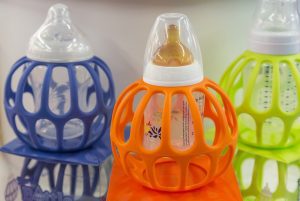
Below are some of the attributes of the best slow flow baby bottle for younger babies and older babies. This gives a higher possibility of having a satisfied baby’s tummy every time, all the time.
Anti-Colic Feature
It’s not fun nor entertaining to see your baby cry for more than 3 hours a day even as you have done all you can to try and soothe them. One of the reasons for this behavior is colic. It is a pain felt in the abdomen caused by intestinal gas. It happens mostly to infants since they do not move around and have a harder time expelling gas. To avoid colicky behavior, choose a bottle that has an anti-colic feature. This way, the bottle is completely ventilated, and the infant is drinking liquid, not unwanted air intake.
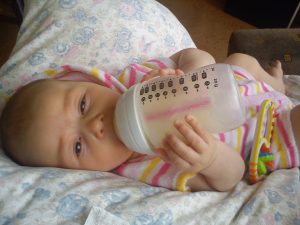

BPA-Free Certified
The best slow-flow bottles for babies should also be BPA-free. BPA stands for Bisphenol A., which is a chemical that is used for polycarbonate plastics and polycarbonate resins. These are usually used in food and beverage containers, such as take-out plastics and bottles. Although the Food and Drug Administration has stated that containers with BPA are safe, other studies have shown that this chemical may seep into food and beverage. Even if one agrees and the other says the opposite, there is no harm to better choose a BPA-free only bottles.
On another note, the flexible nipple on the bottle has different flow rates. A slow-flow nipple allows the liquid to flow at a slower rate. The slow flow nipple is highly preferred for babies that are transitioning from breastfeeding to upright feeding as the milk flow is better suited for them. The slow flow nipple is ideally chosen for 0 to 6 months old babies. Based on research, parents have been saying that slow flowing nipples are best for less than a year old babies. Once they get older than this range, you can see how your baby likes a medium-flow nipple.
Having noted a few things to keep in mind, here’s a list of some of the best slow-flow bottles for babies.
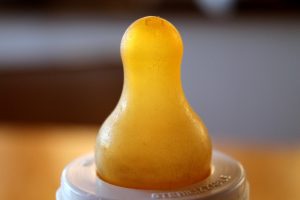

Comotomo Slow Flow Newborn Baby Bottles
One of the best baby slow-flow nipples is from Comotomo. The uniquely designed Comotomo baby bottle uses a squishy silicone material that resembles the skin, soft to the touch. It’s microwave-safe, can withstand heat, and is safe inside the dishwasher. Furthermore, due to its wide-neck design, these are easy to clean by hand with bottle brush. Comotomo have a dual anti-colic vent! This way, the bottle is ventilated, leaving the baby with a happy stomach, no air intake bubbles, and even a peaceful sleep.
Lansinoh Momma Bottle With Natural Wave Nipple
This slow-flow nipple and bottle set is clinically proven to reduce nipple confusion between the breast and bottle for the little ones! Lansinoh Bottle with Natural Wave allows the baby to have a smooth transition from breastfeeding to bottle-feeding. It also includes the same features from above, an AVS (Air Ventilation System) that reduces the intake of gas through the baby’s milk flow and is also BPA-free and BPS-free. BPS is Bisphenol S, just like BPA, it is also a chemical that can affect human health negatively.
Furthermore, this bottle has fewer parts, making it easy to clean and put together. They have three choices for flow type nipples; slow flow nipples, medium flow nipples, and fast flow that wholly depends on the needs of your baby. Although these are safe inside the dishwasher, Lansinoh recommends gentle hand cleaning instead of throwing it in the dishwasher to prolong the bottle’s life. They are also safe in boiling water. However, they do not recommend microwaving the milk as this can damage breastmilk nutrients.
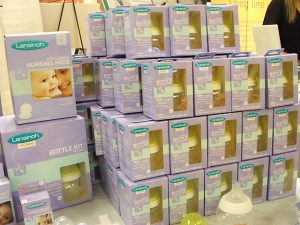

Dr. Brown’s Best Slow Flow Bottles For Newborns
For four years in a row, Dr. Brown’s bottles have been chosen as Moms’ Picks: Best Baby Bottle! You can easily prove that babies like it and mother’s instantly have it in their Top 1! These best slow flow bottles for babies are BPA-free, free from harmful chemicals that may harm your baby, and easy to clean. It is also unlike other bottles because it is fully-vented for vacuum-free feeding. Baby drinks their milk or formula at their own pace, and it reduces colic, spit-up, and gas. Even as it is elongated shape like the traditional ones so it is easy to hold and because of the fully-vented system, it is considered closest to breastfeeding because of the natural feel.
Overall it all depends on your baby. Options may have been made weighed carefully, but if your baby doesn’t approve, there’s no choice but to move on to the next one on the list. It’s all about trial and error and the satisfaction of your child. One last thing to consider is the compatibility of these containers with the breast pump directly you have. Normally, this is not something breastfeeding moms think about but always ensure that that this is compatible with the baby products you already own.
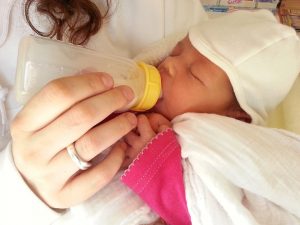

Top Slow Flow Bottles For Babies FAQs
There is an assortment of top-quality gentle stream containers available on the market designed to cater to infants’ unique feeding needs. It’s essential to research and choose wisely, based on factors such as material quality, nipple design, and venting system.
Gradual flow containers can help mitigate common issues such as colic or gas by mimicking natural breastfeeding more closely than their standard counterparts. This facilitates an easier transition between breastfeeding and bottle-feeding for both mother and child.
Infants who experience difficulty with standard bottles or struggle with gas or colic might benefit from gentle stream containers due to their closer resemblance to natural breastfeeding patterns. Consultation with a pediatrician can provide further guidance on individual needs.
Options include glass, silicone or polypropylene for optimal quality, durability and child-safety considerations. Select what feels most appropriate after assessing your particular requirements.
Refer to each product’s specific care instructions coming from its manufacturer before constructing a proper maintenance routine involving sterilization techniques like boiling water immersion or using steam sanitizing appliances.
Slow-paced vessels will prove invaluable throughout integrating various nursing methods while ensuring comfortability as well as consistency over time during this crucial developmental period both for parents and their offspring.
What Is The Slowest Flow Bottle For The Newborn?
Tommee Tippee’s Closer to Nature First Feed Bottle is among the slowest flow bottles for newborn babies. The Tommee Tippee bottles come with an extra slow-flow nipple. Babies and parents love the Tommee Tippee Closer to Nature best slow flow bottle because the nipple is shaped like the natural breast and feels like one too with its natural feel. This makes it easier for babies to transition from the breast to the bottle. The Tommee Tippee Closer to Nature bottle also has an easy good latch feature with one of the best natural feel, easy to hold grip around. The Tommee Tippee is also easy to clean, helps prevent air bubbles in your baby’s mouth with the built-in venting system, and works great with both breast milk or formula. These containers and nipples make for great baby shower gifts too!
What Bottle Is Best For Newborns?
Select the ideal feeding vessel for infants. This specific type of container is designed to enable them to ingest sustenance at a leisurely pace. Distinguishing itself from ordinary or medium-flow bottles, it permits breast milk to trickle gradually and consistently.
Are Slow Flow Nipples Better For Newborns?
Slow flow nipples are better for newborns to avoid over-feeding them. The latter usually happens with regular nipples. Slow flow nipple help with gas and colic because of the anti-colic valve and venting system they have.
Can Slow Flow Of Silicone Bottles Slow Flow Nipple Cause Gas?
Yes, slow flow nipples can sometimes make babies gassy. This is one of the disadvantages of using slow nipple flow.
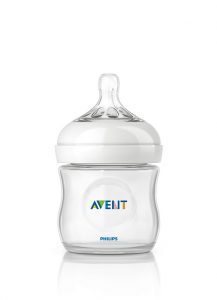

Is There Another Bottle I Should Consider For My Baby?
One last bottle set that you should consider for your baby Philips Avent Natural baby bottle. The Philips Avent Natural bottle has a wide breast-shape that promotes easy latching. You will also find that the Philips Avent natural baby products have different nipples that help with breast milk flow. This means you can choose a slow flow nipple or a medium flow nipple, depending on what is best for you baby. The natural feel of this Philips Avent Natural baby bottle ensures the breast and bottle experience is seamless for your baby. You can also use the Philis Avent Natural bottle soft silicone nipple for breast milk or formula.
How Fast Should Newborn Drink Bottle?
Selecting the best baby bottles for newborns is crucial in their early stages of growth. Spending 20-40 minutes using the best slow flow bottles for babies can be effective for those aged up to three months. From 3 to 6 months, 15-30 minutes of feeding time is recommended. For older babies over six months, reducing the feeding duration to 10-20 minutes is advisable.
In the market, there are plastic baby bottles and glass baby bottles catering to different preferences. For breastfed babies, mam bottles are ideal, as they mimic the mother’s breast. Considering the size of the baby bottle is vital to ensure a comfortable feeding experience.
Anti-colic vents in bottles can significantly reduce gas and discomfort in babies. BPA-free plastic and dishwasher-safe bottles provide additional safety and convenience. Comotomo bottles are known as some of the best bottles for breastfed babies due to their soft silicone design.
It is essential to store enough plastic bottles in the diaper bag while exclusively bottle feeding. The proper bottle selection is crucial for both younger and older babies. For breast pumps compatibility, popular baby bottles are recommended.
A silicone sleeve can protect glass baby bottles during travel. An anti-colic bottle is a must for babies prone to gas issues. As the baby takes to sipping, transitioning from bottles to sippy cups is the next step. Eventually, moving to larger bottles will be necessary as the baby grows and requires more nutrients.
How Do I Know If My Baby’s Teat Is Too Fast?
In identifying the best baby bottles for breastfed babies, it’s crucial to consider the size baby bottle and the speed of the teat flow. If the flow is too fast, there are several indicators to watch for: the infant may cough and choke on the milk, spill more milk than they swallow, clamp their mouth shut or push the bottle away, and refuse to feed.
Selecting an anti colic bottle with built-in anti colic vents is essential to help minimize regurgitation, especially when the breastfed baby becomes active right after feeding. Rapid milk flow can lead to the little one consuming more than necessary just to fulfill their sucking needs.
When choosing the best baby bottles, look for those made from BPA free plastic that are dishwasher safe, ensuring a convenient and safe feeding experience. Keeping an eye on these key factors, informed individuals can make better choices for the most suitable bottles for their breastfed babies, fostering a healthy and comfortable feeding process.
Can You Freeze A Reusable Silicone Pouch Bottle?
Most bottles might experience harm to their reusable rubber silicon composition if frozen, potentially leading to leaks during subsequent usage. On the other hand, filling the best bottle with cold water is entirely safe and can be an effective means of staying cool during a heatwave.
How Many Bottles Of Milk Can A Newborn Consume?
Be sure to 2 to 3 ounces of milk for newborns during the first weeks and adjusting as needed, being mindful of an infant’s hunger signals. Emphasizing the importance of knowing how much babies consume at various stages, they note that newborns typically intake 1.5 to 3 ounces every 2 to 3 hours, with formula-fed newborns feeding 8 to 12 times in a 24 hour period.
When Can Babies Go 4 Hours Between Feedings?
It can be noted that newborns typically slumber for two to three hours before needing nourishment around the clock. Around two months of age, they usually consume 4 to 5 ounces per meal every three or four hours; at four months, this increases to 4-6 ounces. By six months old, babies can potentially ingest up to 8 ounces and go without eating for longer nighttime intervals. As they continue growing and developing between the ages of two and three months old, healthy babies should be capable of sleeping for six-hour stretches without requiring feeding.
What Baby Gear Do You Need For Your First Baby?
A couple of nursing pad sets, either disposable or reusable, are necessary for new parents. Having freezer-safe containers for breast/chest milk storage is also essential. Gathering at least half a dozen burp cloths is a great idea; alternatively, receiving blankets or cloth diapers can be used as well. Protecting babies from harm and providing optimal newborn care should be every infant’s right — ensuring they can breathe properly, stay warm, and receive proper nourishment in their crucial first days of life.
How Do Munchkin Latch Bottles Work?
The nipple design effectively simulates the natural movement of a real one, promoting proper latching for babies. Besides, it features an anti-colic valve to minimize air ingestion and prevent leakages, ensuring that milk is only released during active sucking.
How Do You Know When To Size Up Same Nipple Bottle?
Age doesn’t necessarily dictate the need to advance a nipple level for bottle-feeding babies. It’s possible for an infant to remain on the same level throughout their bottle-feeding journey. However, babies will exhibit indications if the flow isn’t suitable, whether it’s too sluggish or too rapid. Typically, Level 1 is for newborns (0-3 months), Level 2 suits those aged 3-6 months, Level 3 caters to babies aged 6 months and up, and Level 4 is designed for those aged nine months or older.
Are Glass Bottles Safe For Babies?
Glass baby bottles hold the title of the most secure option among their counterparts. These bottles are immune to chemical leakage at elevated temperatures and boast an impressive longevity. With a non-toxic composition, glass baby bottles come without traces of BPA, lead, and phthalates.
Is Milk In A Glass Bottle Better?
Best Bottles for Newborns Other Resources
https://www.babylist.com/hello-baby/best-baby-bottles
https://babyjourney.net/slow-flow-bottles-newborns/
https://www.whattoexpect.com/baby-products/nursing-feeding/best-bottles-breastfed-babies
Last Updated on May 15, 2023 by Allen Laconsay
DISCLAIMER (IMPORTANT): This information (including all text, images, audio, or other formats on FamilyHype.com) is not intended to be a substitute for informed professional advice, diagnosis, endorsement or treatment. You should not take any action or avoid taking action without consulting a qualified professional. Always seek the advice of your physician or other qualified health provider with any questions about medical conditions. Do not disregard professional medical advice or delay seeking advice or treatment because of something you have read here a FamilyHype.com.